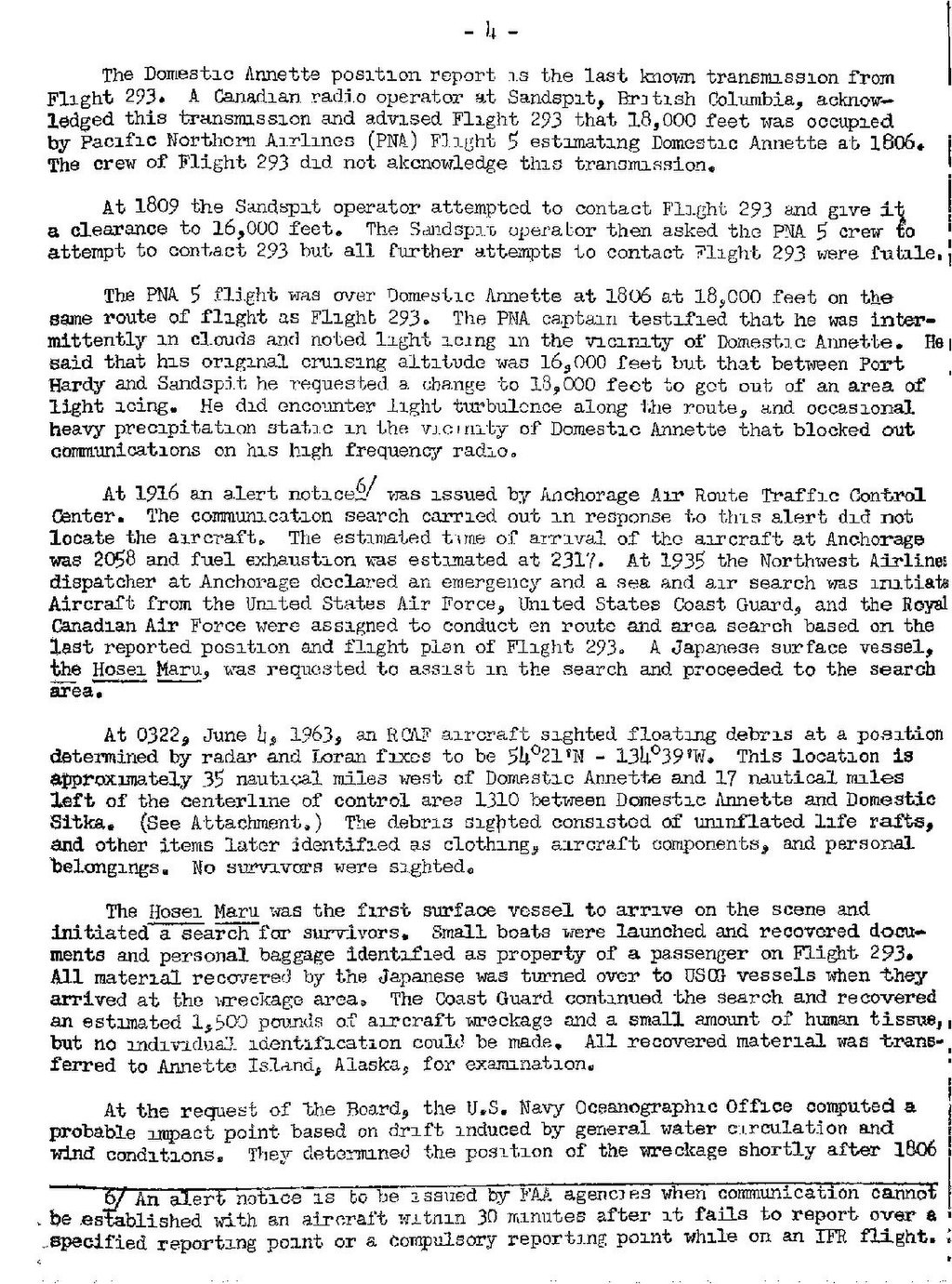- 4 -
The Domestic Annette position report is the last known transmission from Flight 293. A Canadian radio operator at Sandspit, British Columbia, acknowledged this transmission and advised Flight 293 that 18,000 feet was occupied by Pacific Northern Airlines (PNA) Flight 5 estimating Domestic Annette at 1806. The crew of Flight 293 did not akcnowledge this transmission.
At 1809 the Sandspit operator attempted to contact Flight 293 and give it a clearance to 16,000 feet. The Sandspit operator then asked the PNA 5 crew to attempt to contact 293 but all further attempts to contact Flight 293 were futile.
The PNA 5 flight was over Domestic Annette at 1806 at 18,000 feet on the same route of flight as Flight 293. The PNA captain testified that he was intermittently in clouds and noted light icing in the vicinity of Domestic Annette. He said that his original cruising altitude was 16,000 feet but that between Port Hardy and Sandspit he requested a change to 18,000 feet to get out of an area of light icing. He did encounter light turbulence along the route, and occasional heavy precipitation static in the vicinity of Domestic Annette that blocked out communications on his high frequency radio.
At 1916 an alert notice[1] was issued by Anchorage Air Route Traffic Control Center. The communication search carried out in response to this alert did not locate the aircraft. The estimated time of arrival of the aircraft at Anchorage was 2058 and fuel exhaustion was estimated at 2317. At 1935 the Northwest Airlines dispatcher at Anchorage declared an emergency and a sea and air search was initiate Aircraft from the United States Air Force, United States Coast Guard, and the Royal Canadian Air Force were assigned to conduct en route and area search based on the last reported position and flight plan of Flight 293. A Japanese surface vessel, the Hosei Maru, was requested to assist in the search and proceeded to the search area.
At 0322, June 11, 1963, an RCAF aircraft sighted floating debris at a position determined by radar and Loran fixes to be 54°21'N — 134°39'W. This location is approximately 35 nautical miles west of Domestic Annette and 17 nautical miles left of the centerline of control area 1310 between Domestic Annette and Domestic Sitka. (See Attachment.) The debris sighted consisted of uninflated life rafts, and other items later identified as clothing, aircraft components, and personal belongings. No survivors were sighted.
The Hosei Maru was the first surface vessel to arrive on the scene and initiated a search for survivors. Small boats were launched and recovered documents and personal baggage identified as property of a passenger on Flight 293. All material recovered by the Japanese was turned over to USCG vessels when they arrived at the wreckage area. The Coast Guard continued the search and recovered an estimated 1,500 pounds of aircraft wreckage and a small amount of human tissue, but no individual identification could be made. All recovered material was transferred to Annette Island, Alaska, for examination.
At the request of the Board, the U.S. Navy Oceanographic Office computed a probable impact point based on drift induced by general water circulation and wind conditions. Their determined the position of the wreckage shortly after 1806
- ↑ An alert notice is to be issued by FAA agencies when communication cannot be established with an aircraft within 30 minutes after it fails to report over a specified reporting point or a compulsory reporting point while on an IFR flight.
